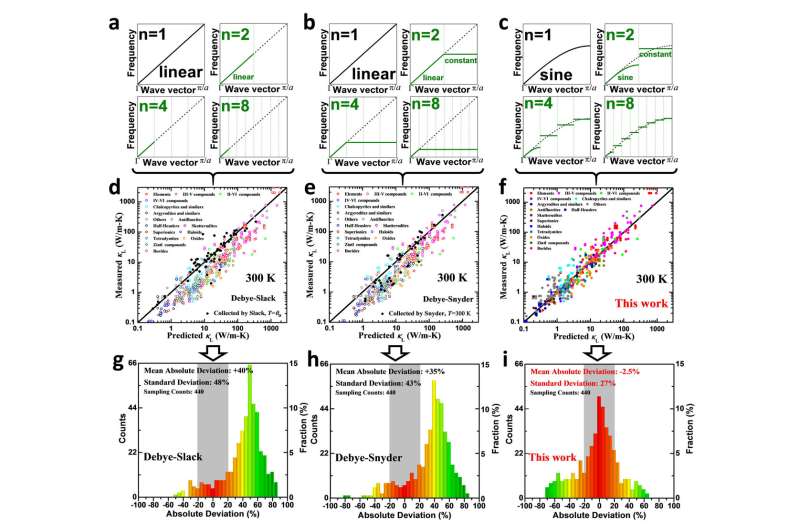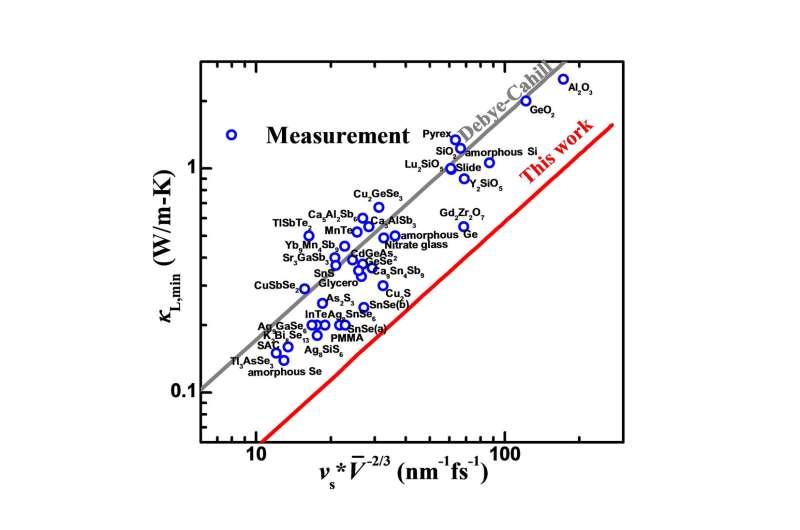Rationalizing phonon dispersion: an efficient and precise prediction of lattice thermal conductivity

Lattice thermal conductivity strongly affects the applications of materials related to thermal functionality, such as thermal management, thermal barrier coatings and thermoelectrics. In order to understand lattice thermal conductivity more quantitatively and in a time- and cost-effective way, many researchers have devoted their efforts and developed a few physical models using approximated phonon dispersions over the past century.
Most of these models use a linear phonon dispersion, proposed by Debye in 1912 based on an acoustic-elastic-wave assumption (Fig. 1a), while other models either involve fitting parameters on phonon dispersion or lack detailed equations for phonon transport properties. The linear phonon dispersion of Debye offers many simplifications on phonon transport properties, and was the most common approximation in the past century. The linear dispersion of Debye successfully predicts the T3 dependence of the heat capacity at very low temperatures, and heat capacity approaches the Dulong-Petit limit at high temperatures. However, the nature of periodicity on atomic arrangements leads to a periodic boundary condition for lattice vibrations in solids (Fig. 1b), which actually creates lattice standing waves at Brillouin boundaries (Fig. 1c). This does not satisfy the acoustic-elastic-wave assumption of Debye, as proposed by Born and von Karman (BvK) in 1912—the same year that Debye proposed the linear dispersion.
This results in a significant deviation of Debye dispersion for periodic crystalline materials when phonons with wave vectors are close to the Brillouin boundaries (high frequency phonons). When these phonons are involved for phonon transport (i.e. at not extremely low temperatures), Debye dispersion leads to an overestimation of lattice thermal conductivity due to the overestimation of group velocity for these high-frequency phonons, as observed in materials with hundreds of known measured lattice thermal conductivity and necessary details for a time- and cost-effective model prediction to our best knowledge (Fig. 2g and h showing a mean absolute deviation of ~+40%). In addition, Debye dispersion overestimates the theoretically available lower bound of lattice thermal conductivity as well, leading the violations of the measured lattice thermal conductivity to be even lower than the current theoretical minimum predicted (based on the Debye-Cahill model) as observed in tens of materials.

This work takes into account the BvK boundary condition, and reveals that the product of acoustic and optical dispersions yields a sine function. In the case of which the mass (or the force constant) contrast between atoms is large, the acoustic dispersion tends to be a sine-function. This sine type dispersion indeed exists in both the simplest and the most complex materials. Approximating the acoustic dispersion to be sine, the BvK boundary condition subsequently reduces the remaining optical branches to be a series of localized modes with a series of constant frequencies. While first-principles calculations enable a more detailed phonon dispersion, a development of rationalized phonon dispersion for a time- and cost-effective prediction of phonon transport is significant due to the time-consuming and computationally expensive for first-principles calculations.
This work utilizes the above-mentioned rationalization of phonon dispersions, which enables both contributions to lattice thermal conductivity of acoustic and optical phonons to be included. This improvement in phonon dispersions significantly improves the accuracy of a time- and cost-effective prediction on lattice thermal conductivity of solids without any fitting parameters (Fig. 2c, showing a mean absolute deviation of only -2.5%), and therefore offers a more precise design of solids with expected lattice thermal conductivity. Furthermore, this work successfully removes the contradiction of the measured lattice thermal conductivity being even lower than the theoretical minimum predicted based on a linear dispersion of Debye (Fig. 3). This would provide the theoretical possibility of rationalizing lattice thermal conductivity to be lower than is currently thought, opening further opportunities for advancing thermally resistive materials for applications, including thermoelectrics.

More information: Zhiwei Chen et al, Rationalizing phonon dispersion for lattice thermal conductivity of solids, National Science Review (2018). DOI: 10.1093/nsr/nwy097
Provided by Science China Press





















